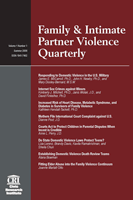Suicide and the Danger Assessment: Links Between Suicide, IPV, and Homicide
Author: Jill Messing.; Jacquelyn Campbell.
Source: Volume 12, Number 01, Summer 2019 , pp.45-50(6)

< previous article |next article > |return to table of contents
Abstract:
The Danger Assessment is an IPV risk assessment that is intended to predict risk for homicide among IPV survivors (www.DangerAssessment.org) and to be used for safety planning. Women who score in the two highest categories of homicide risk (“severe danger” or “extreme danger”) on the Danger Assessment were more likely to have ever threatened or attempted suicide than women in the lowest risk assessment category, even after taking into account other predictors of suicide. This article explores use of the Danger Assessment questionnaire in predicting and preventing suicide among victims of domestic violence. Two highly eminent experts on intimate partner violence and danger assessment discuss the worst-of-the-worst outcomes occurring in the most severe cases of IPV—that is, suicide of the victim and/or the perpetrator, or the death of both partners via murder suicide. While victims of IPV themselves have a greater risk of suicide, especially when the violence has been chronic, long-lasting, and severe, they also have a higher risk of being killed by their abuser. And, the authors add, among the predictors of lethality is the abuser’s own threats to kill himself, a threat that is commonly reported by survivors of IPV.Keywords: Suicide and posttraumatic stress disorder, anxiety, and depression; acquired capability
Affiliations:
1: Arizona State University; 2: Johns Hopkins University School of Nursing .